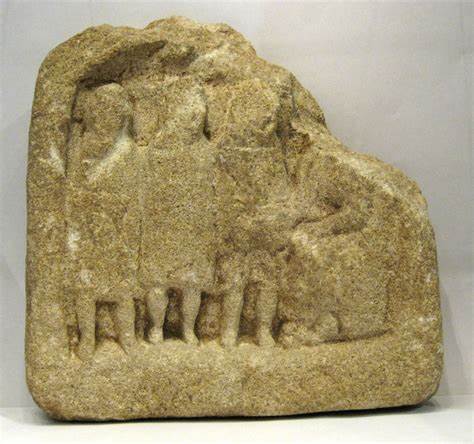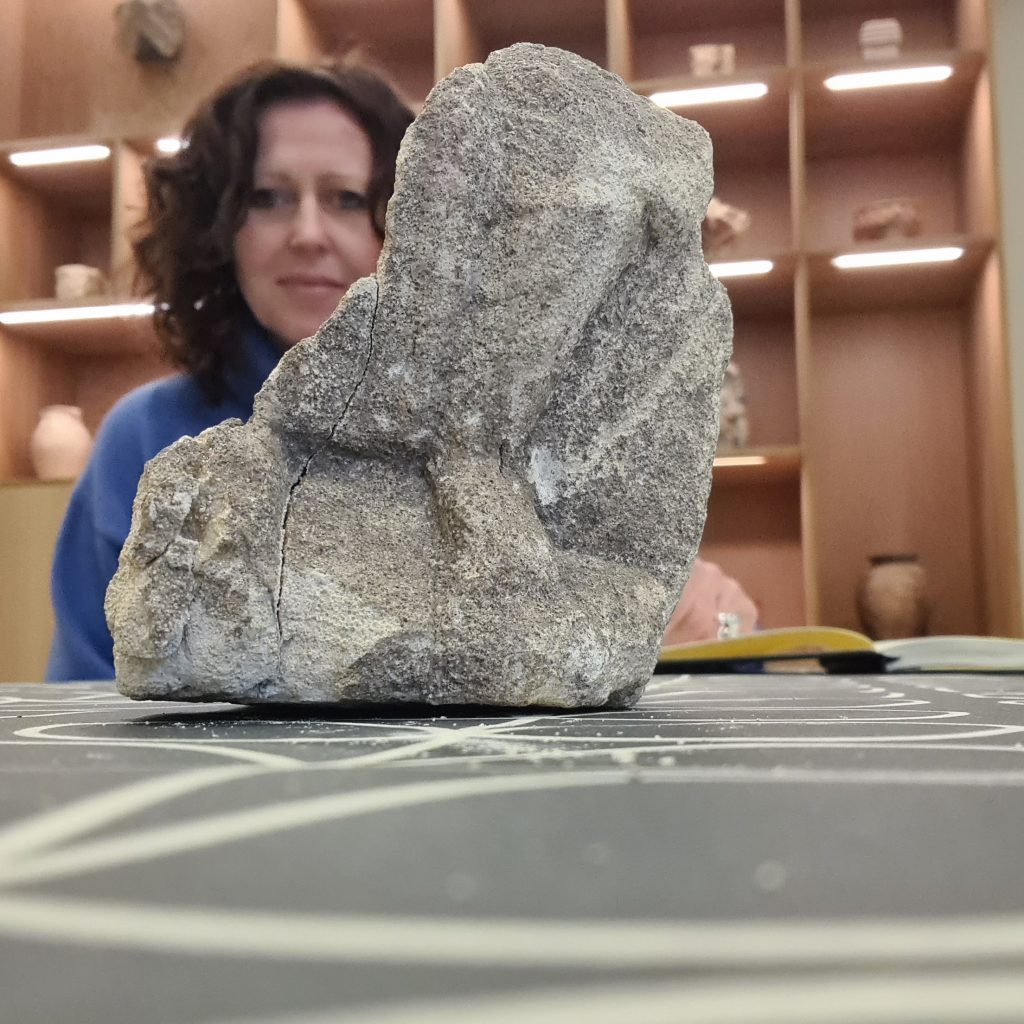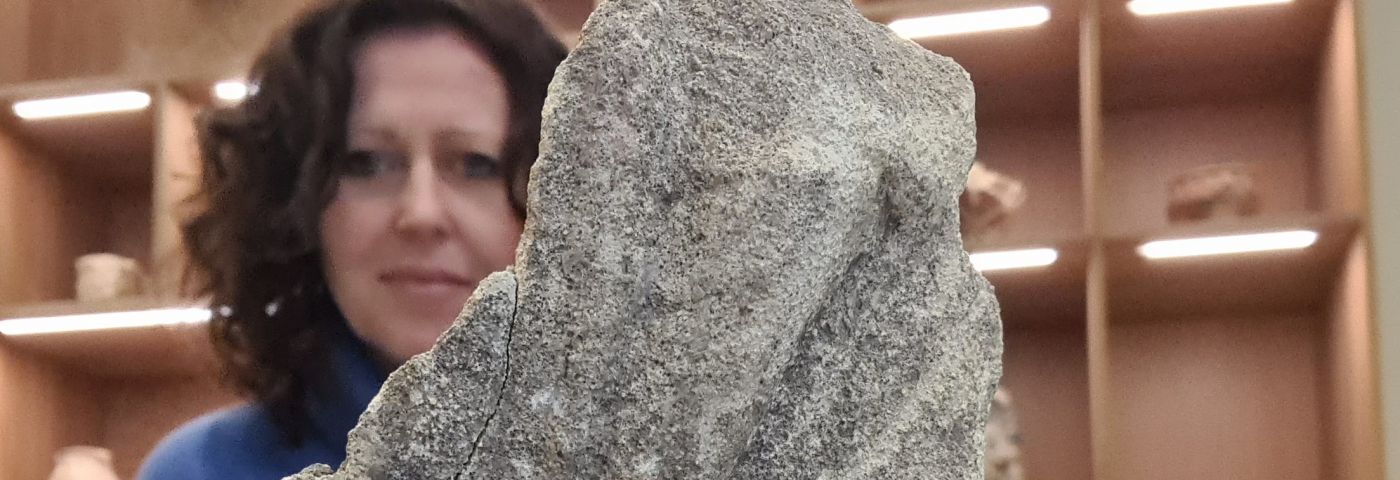Blog post by JLM Morton, Corinium Museum’s poet in residence
Last year, I swam, walked and waded along the River Churn, just over 23 miles from its source at Seven Springs to its confluence with the Thames at Cricklade. My intention was to write a series of interlinked poems about invasion and migration in response to my (literally) immersive return to my home river. However, during the journey, my focus shifted to ideas of home, belonging, motherhood and a conversation with the genius loci embodied in the ‘goddess’ Cuda.

Romano-British votive relief depicting three hooded godlets (genii cucullati) and a goddess (mater), found at Daglingworth, Gloucestershire, in 1951.
CVDA / CHURN
Churn’s name is ancient, possibly an iron age Dobunni word – there are many cognate or related names and elements in the local area: Cerney, Ciren, Corin, Corinium – all of which are found along the course of the Churn.
A votive relief with the word ‘CUDAE’ was turned up in a field in Daglingworth in 1690, giving a possible name to the mother goddess associated with the local spirit cult.
Etymologists have speculated that ‘Cuda’ is a predecessor to the word Cotswold, via coda / cotta / cotts.
A number of stone reliefs and statues of mother goddesses and the genii culculatti are held in the Corinium Museum collection.
A sonnet sequence, ‘Churn’(1) and a fragmentary poem ‘Cuda ex nihilo’ emerged from this experience. My interest in the Romano-Celtic mother goddess cult that had Corinium at its epicentre was sparked, drawing me to the Museum which holds the votive relief on which the name ‘CUDAE’ is carved. My residency will explore the museum collection with a poetic lens, deepening and illuminating our understanding of the mother goddess cult and associated genii culculatti, the three guardian spirits that accompany the matres and honour the significance of triplism in Celtic belief systems.

Romano-British limestone votive relief depicting three cloaked godlets (genii cucullati), found in Cirencester, probably in the Ashcroft area, in 1892.
On my very first visit to the Museum as poet in residence, I was welcomed to the Winstone Learning Centre by Emma Stuart, Corinium’s Learning and Development Officer. She gave me some books and a box containing a fragment of a mother goddess statue and left me to ‘contemplate’ the statue.
How strange, I thought, at first.
But spending time in the presence of a 2000 year old statue is a uniquely powerful experience: handling the weight of it, feeling the surfaces with my fingertips, seeing up close the fragments of fossil and quartz held within the oolitic limestone. The head and body of the mater is missing – whether deliberately desecrated by later Christians or victim to the ravages of time – but it is still possible to clearly make out the heavy draping of fabric over the leg and the shape of the foot. The stone is marked by cuts and paler areas where the surface has worn way. To my surprise, there was an embodied energy in the figure that it was hard not to respond to.

JLM Morton with mother goddess statue fragment.
After my time in the Winstone Learning Centre, I popped upstairs to pay respects at the cabinet where the other mother goddesses are held. Each time I visit, I notice a different aspect of the stone reliefs – a carving mark here, a detail on a figure there.
I took some photographs, as I always do on research trips – keeping a visual aide memoir is a vital part of my practice. I was especially taken by how the frame on my phone camera kept popping up to frame the faces of the matres when I took pictures of the stone figures. It was as if they were somehow reaching into my world from the past. And it was this image that stayed with me in the development of my first piece for the residency: Matres.
Matres
JLM Morton
When I hold my mother
within me, it is the way stone
is made up of so many thousand
minerals, the ossified body of a mollusc,
the memory of heat in quartz.
If I frame the statue’s face
with my camera, see
her robust arms draw in,
it is my child asking me
to guard the warm spot as she runs
to another room and returns,
jumping back in just to feel
the weightlessness.
My grandmother is a hare
running at speed, eyes set high
with an orbital range. I am seen.
And the hare’s gaze rests upon me.
I rest, the way the weather
has worn soft the statue’s ministrations.
This is how I hold the fragment,
as if the weight is something
I could travel through and the places
where touch has lightened the patina
are pathways to the sacred.
Climb inside my mother’s
mother’s mother’s urn and see
how it is filled with fireflies.
Hounds and children curl
around my legs. What sound
is there for this ritual?
Perhaps a growl, long and steady,
as my camera frames
the face of the mater.
Sometimes the rain extinguishes.
But the body is a record,
mongrel strata layered
with different versions of childhood,
barking and simpering
in their Jurassic furs. Yet loyal
as stone. Which is how
I would like to be held.
Find out more about JLM Morton’s work here https://www.jlmmorton.com/
References
(1) ‘Churn’ was commissioned by Cardiff University academics Charlotte Bates and Kate Moles as a contribution to the monograph Living With Water (Manchester University Press, forthcoming 2023). This brings together sociologists, anthropologists, geographers, artists and poets to explore the way water binds, immerses and supports us.










